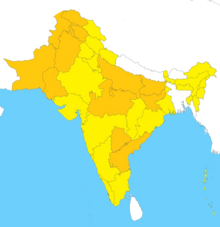ភាសាអ៊ូរឌូ
| អត្ថបទនេះត្រូវការបកប្រែពី ភាសាអង់គ្លេស ទៅជាភាសាខ្មែរ។ អត្ថបទនេះត្រូវបានសរសេរជាភាសាអង់គ្លេស។ បើសិនជាអត្ថបទទុកសម្រាប់អ្នកអានមកពី ភាសាអង់គ្លេស language community វាគួរតែចែកចាយទៅវិគីភីឌាជាភាសានោះ។ សូមមើល បញ្ជីនៃគម្រោងវិគីភីឌាទាំងអស់។ សូមមើល ច្រកចូលអត្ថបទនេះ លើក្រុមទំព័រដែលត្រូវការបំណកប្រែទៅជាភាសាខ្មែរ ដើម្បីពិភាក្សា ។ ប្រសិនបើ អត្ថបទមិនត្រូវបានសរសេរជាភាសាខ្មែរឡើងវិញទេ ក្នុងរយៈពេលពីរសប្ដាហ៍ទៀត អត្ថបទនឹងត្រូវចុះបញ្ជីដើម្បីលុបចោល និង/ឬ ប្ដូរវាទៅកាន់ភាសាអង់គ្លេស Wikipedia ។ បើសិនជាលោកអ្នក គ្រាន់តែចង់បិទស្លាកទំព័រនេះត្រូវការបំណកប្រែ សូមបញ្ចូល {{អាទេស.:ត្រូវការបកប្រែ | ទំ. = ភាសាអ៊ូរឌូ | ភាសា = ភាសាអង់គ្លេស | ផ្ដល់យោបល់ = }} ~~~~ទៅខាងក្រោម នៃផ្នែក នៃក្រុមទំព័រនេះត្រូវការបំណកប្រែទៅជាភាសាខ្មែរ ។ |
| ភាសាអ៊ូរឌូ | |
|---|---|
| Lashkari (لشکری) | |
| ទំព័រគំរូ:Nq | |
 Urdu in Nastaʿlīq script | |
| ការបញ្ចេញសំឡេង | [ˈʊrduː] ( |
| ដើមកំណើតនៅ | India and Pakistan |
| តំបន់ | អាស៊ីខាងត្បូង |
| ជាតិពន្ធុ (ជនជាតិ) | Urdu-speaking people (Muslims of the Urdu Belt, the Deccani people and the Muhajir people)[១] |
អ្នកនិយាយដើមកំណើត | Expression error: Unrecognized punctuation character "២". Total: 230 million (2021)[៣] |
ទម្រង់ដើម | |
| គ្រាមភាសា | |
| |
| |
| ស្ថានភាពផ្លូវការ | |
ភាសាផ្លូវការនៅក្នុង | (national)
|
ភាសាជនជាតិភាគតិច ត្រូវបានទទួលស្គាល់ | |
| គ្រប់គ្រងដោយ | National Language Promotion Department (ប៉ាគីស្ថាន) National Council for Promotion of Urdu Language (ប្រទេសឥណ្ឌា) |
| កូដភាសា | |
| ISO 639-1 | ur |
| ISO 639-2 | urd |
| ISO 639-3 | urd |
| ហ្គ្រតតូឡក | urdu1245 |
| Linguasphere | 59-AAF-q |
 Areas in India and Pakistan where Urdu is either official or co-official
Areas where Urdu is neither official nor co-official | |
ភាសាអ៊ូរឌូ គឺជាភាសាឥណ្ឌូ - អឺរ៉ុបនៃត្រកូល Indo-Aryan ដែលត្រូវបានបង្កើតឡើងក្រោមឥទ្ធិពលរបស់ ពែរ្ស, ទួរគីនិងអារ៉ាប់នៅអាស៊ីខាងត្បូងក្នុងសម័យស៊ុលតង់នៃដេលីនិងចក្រភពម៉ុងហ្គោល (១២០០-១៨០០) ។
Urdu became a literary language in the 18th-century and two similar standard forms came into existence in Delhi and Lucknow; since 1947 a third standard has arisen in Karachi.[១០][១១] Deccani, an older form used in the south, became a court language of the Deccan Sultanates in the 16th century.[១២][១១]
Urdu was chosen as the language of East India Company rule across northern India in 1837 when the Company chose it to replace Persian, the court language of the Indo-Islamic empires.[១៣] Religious, social, and political factors arose during the colonial period that advocated for a distinction between Urdu and Hindi, leading to the Hindi–Urdu controversy.[១៤]
According to Nationalencyklopedin's 2010 estimates, Urdu is the 21st most spoken first language in the world, with approximately 66 million who speak it as their native language.[១៥] According to Ethnologue's 2018 estimates, Urdu, is the 11th most widely spoken language in the world,[១៦] with 170 million total speakers, including those who speak it as a second language.[១៧]
ឯកសារយោង
[កែប្រែ]- ↑ Carl Skutsch (7 November 2013). Encyclopedia of the World's Minorities. Taylor & Francis. pp. 2234–. ល.ស.ប.អ. 978-1-135-19395-9. https://books.google.com/books?id=iSUKAgAAQBAJ&pg=PT2234.
- ↑ ទំព័រគំរូ:E24
- ↑ "What are the top 200 most spoken languages?". Ethnologue. Retrieved 2021-02-26.
- ↑ ទំព័រគំរូ:ELL2
- ↑ Gaurav Takkar. "Short Term Programmes". punarbhava.in. Archived from the original on 15 November 2016. Retrieved 29 March 2015.
{{cite web}}: More than one of|archivedate=and|archive-date=specified (help); More than one of|archiveurl=and|archive-url=specified (help) - ↑ "Indo-Pakistani Sign Language", Encyclopedia of Language and Linguistics
- ↑ "Urdu is Telangana's second official language" (ជាen-US). The Indian Express. 16 November 2017. http://indianexpress.com/article/india/urdu-is-telanganas-second-official-language-4940595/.
- ↑ "Urdu is second official language in Telangana as state passes Bill". The News Minute. 17 November 2017. https://www.thenewsminute.com/article/urdu-second-official-language-telangana-state-passes-bill-71742.
- ↑ "Constitution of the Republic of South Africa, 1996 - Chapter 1: Founding Provisions". www.gov.za. Retrieved 6 December 2014.
- ↑ Schmidt, Ruth Laila (8 December 2005) (ជាen). Urdu: An Essential Grammar. Routledge. ល.ស.ប.អ. 978-1-134-71319-6. "Historically, Urdu developed from the sub-regional language of the Delhi area, which became a literary language in the eighteenth century. Two quite similar standard forms of the language developed in Delhi, and in Lucknow in modern Uttar Pradesh. Since 1947, a third form, Karachi standard Urdu, has evolved."
- ↑ ១១,០ ១១,១ Mahapatra, B. P. (1989) (ជាen). Constitutional languages. Presses Université Laval. p. 553. ល.ស.ប.អ. 978-2-7637-7186-1. "Modern Urdu is a fairly homogenous language. An older southern form, Deccani Urdu, is now obsolete. Two varieties however, must be mentioned viz. the Urdu of Delhi, and the Urdu of Lucknow. Both are almost identical, differing only in some minor points. Both of these varieties are considered 'Standard Urdu' with some minor divergences."
- ↑ Dwyer, Rachel (27 September 2006) (ជាen). Filming the Gods: Religion and Indian Cinema. Routledge. ល.ស.ប.អ. 978-1-134-38070-1. https://books.google.com/books?id=ZsKR1RKoJKUC&q=urdu+language+of+deccan+courts&pg=PA103.
- ↑ Metcalf, Barbara D. (2014). Islamic Revival in British India: Deoband, 1860-1900. Princeton University Press. pp. 207–. ល.ស.ប.អ. 978-1-4008-5610-7. https://books.google.com/books?id=BdH_AwAAQBAJ&pg=PA207. "The basis of that shift was the decision made by the government in 1837 to replace Persian as court language by the various vernaculars of the country. Urdu was identified as the regional vernacular in Bihar, Oudh, the North-Western Provinces, and Punjab, and hence was made the language of government across upper India."
- ↑ Ahmad, Rizwan (1 July 2008). "Scripting a new identity: The battle for Devanagari in nineteenth century India". Journal of Pragmatics 40 (7): 1163–1183. DOI:10.1016/j.pragma.2007.06.005.
- ↑ Mikael Parkvall, "Världens 100 största språk 2007" (The World's 100 Largest Languages in 2007), in Nationalencyklopedin. Asterisks mark the 2010 estimates Archived 11 November 2012 at the វេយប៊ែខ ម៉ាស៊ីន. for the top dozen languages.
- ↑ "Urdu 11th most spoken language in world: Study". Deccan Chronicle (in អង់គ្លេស). 20 January 2019. Retrieved 3 December 2019.
- ↑ "What are the top 200 most spoken languages?". Ethnologue (in អង់គ្លេស). 3 October 2018. Retrieved 3 December 2019.
- Pages with script errors
- CS1 errors: redundant parameter
- Pages containing cite templates with deprecated parameters
- តំណវេយប៊ែខទំព័រគំរូវេបបណ្ណសារ
- CS1 អង់គ្លេស-language sources (en)
- អត្ថបទវិគីភីឌាដែលត្រូវការបកប្រែ
- Articles containing Urdu-language text
- Languages with ISO 639-2 code
- Languages with ISO 639-1 code
- Language articles without reference field
